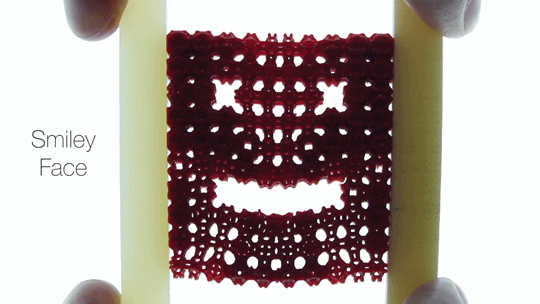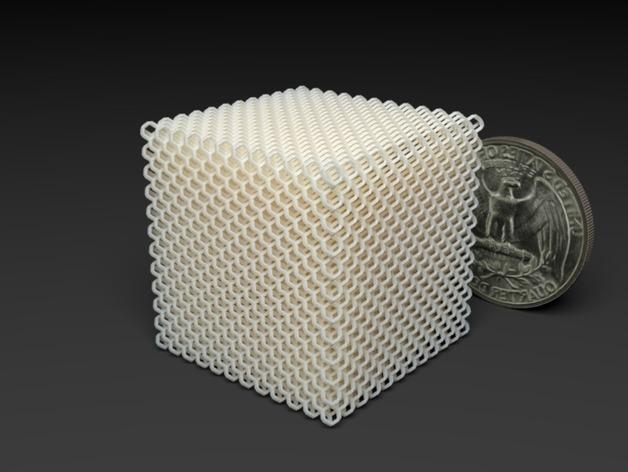 There’s a lot to be said for the wonders of 3D printing technology, but what’s even better is that we are learning to bend innovation so far to our will that it’s able to morph like magic into almost whatever we need. This is being seen with a number of smart materials, and fabric and apparel are at the top of the list for intuitive 3D printing.
There’s a lot to be said for the wonders of 3D printing technology, but what’s even better is that we are learning to bend innovation so far to our will that it’s able to morph like magic into almost whatever we need. This is being seen with a number of smart materials, and fabric and apparel are at the top of the list for intuitive 3D printing.
It’s impressive beyond belief really that we can manage not only to make 3D products from our homes, nearly out of thin air, but also that we can now make use of materials that are like none we’ve ever seen before–and bend them almost completely to our will–causing them to adapt to certain environments and allowing for a host of contemporary new conveniences.
Materials research, something that used to sound rather intimidating and rather vague in one of those super-scientific manners, is now something we hear about on a regular basis. And we’re seeing results in the form of materials like elastic textures, recently demonstrated from research by Julian Panetta, Qingnan Zhou, Luigi Malomo, Nico Pietroni, Paolo Cignoni, and Denis Zorin.
 The research team has produced a collection of 3D printed elastic forms that show specific flexibility in isolated areas within the pieces, which would seem to offer potential for any number of sectors from apparel to creating architectural structures that must contend with mechanical load issues. These types of materials can often handle stressors and environmental pressures without causing any fracture or denigration to say, a building, or a bridge.
The research team has produced a collection of 3D printed elastic forms that show specific flexibility in isolated areas within the pieces, which would seem to offer potential for any number of sectors from apparel to creating architectural structures that must contend with mechanical load issues. These types of materials can often handle stressors and environmental pressures without causing any fracture or denigration to say, a building, or a bridge.
In researching the microstructures, the scientists were able to create some forms that are not only aesthetically pleasing but also interesting in that the 3D printed material is made of tileable, cubic patterns that are exponentially softer than other patterns, and doesn’t require any supports while being manufactured.
“Using a combinatorial search over topologies followed by shape optimization, we explore a wide space of wireframe-like, symmetric 3D patterns to obtain a small family,” states the research team. “This pattern family can be printed without internal support structure on a single-material 3D printer and can be used to fabricate objects with prescribed mechanical behavior.”
 The key is in finding out exactly how those mechanical behaviors can work for real-world, utilitarian needs. The materials transform as different types of pressure are applied. They demonstrate a material bar that bends at quite an impressive angle when pushed, a one-third bend, as well as a bar compression with an ‘S’ shape. Malleable cube shapes featuring lattice-work interiors are as small as 2.5 mm, with a thickness of .25mm, reminding one of the bedspring concept–and in fact, these would probably as a great improvement on much traditional spring technology.
The key is in finding out exactly how those mechanical behaviors can work for real-world, utilitarian needs. The materials transform as different types of pressure are applied. They demonstrate a material bar that bends at quite an impressive angle when pushed, a one-third bend, as well as a bar compression with an ‘S’ shape. Malleable cube shapes featuring lattice-work interiors are as small as 2.5 mm, with a thickness of .25mm, reminding one of the bedspring concept–and in fact, these would probably as a great improvement on much traditional spring technology.
Control in bending and twisting are also afforded by the innovative material, best demonstrated upon being squeezed in a vice grip. This would seem to be a perfect example of how it could withstand stress in a construction situation, reverting back to its natural shape afterward.
Have you been involved in 3D printing any soft and flexible fabric microstructures like these? Discuss in the 3D Printed Microstructures forum thread over at 3DPB.com.
Subscribe to Our Email Newsletter
Stay up-to-date on all the latest news from the 3D printing industry and receive information and offers from third party vendors.
Print Services
Upload your 3D Models and get them printed quickly and efficiently.
You May Also Like
Could 3D Printing for Biocomputing Make Wetware Aware?
As an AI arms race consumes ever more electricity, and every ChatGPT search query costs $0.36, the search for new ways of computing has intensified. One answer could be in better...
Bambu Lab Launches Software to Manage 3D Printer Fleets—No Cloud Needed
Bambu Lab has introduced a new software tool, Bambu Farm Manager, designed to help users manage large fleets of 3D printers over a local network, without relying on the cloud....
Consolidation in AM: How 2025 Is Shaping the Industry’s New Normal
The first half of 2025 has been marked by a clear shift in the additive manufacturing (AM) industry. Companies are no longer just focused on developing new tech by themselves....
3D Printing News Briefs, July 2, 2025: Copper Alloys, Defense Manufacturing, & More
We’re starting off with metals in today’s 3D Printing News Briefs, as Farsoon has unveiled a large-scale AM solution for copper alloys, and Meltio used its wire-laser metal solution to...
































